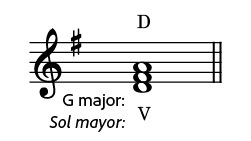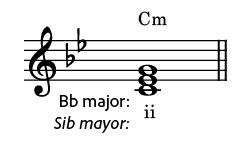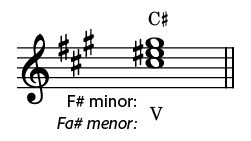Reference : identifying triads
Being able to identify triads quickly and accurately is essential if you want to be able to analyze and understand the music you are performing or listening to. Therefore, it is important to develop the ability to identify intervals, especially thirds and fifths.
Using your knowledge of intervals, you can quickly identify triads. One way to do this is to identify the third and then the fifth. The following table shows the combination of intervals characteristic of each type of triad:
| Triad | Third | Fifth | Examples |
|---|---|---|---|
| Major | major | perfect |  |
| Minor | minor | perfect |  |
| Diminished | minor | diminished |  |
| Augmented | major | augmented |  |
You can also identify the two thirds that make up the chord. The following table shows the combination of intervals characteristic of each type of triad:
| Triad | First third | Second third | Examples |
|---|---|---|---|
| Major | Major | Minor |  |
| Minor | Minor | Major |  |
| Diminished | Minor | Minor |  |
| Augmented | Major | Major |  |
Alternative for identifying triads:
Knowing the type of triad built on each scale degree can help you identify triads quickly.
Here are a few examples:

D major. Here the key is G major. The chord is built on the V degree of the scale. Triads formed on the fifth degree of the major scale are major.

C minor. Here the key is B flat major. The chord is on the second degree. Triads built on the II degree of major scales are are always minor triads.

C# major. There are two ways to identify the type of triad.
- First, you can see that the key is A major. A triad based on the III degree of the major scale is minor, but here the third of the chord is a major third because it has been raised. Therefore, the triad is major.
- Or you can notice that the key is F# minor. E# is characteristic of harmonic and melodic minor scales. Therefore, in both cases, the chord based on the V degree is major.
See C > Chord for related entries.
